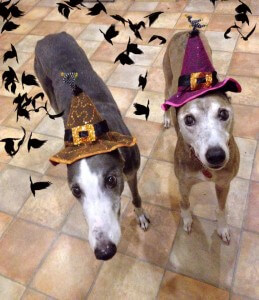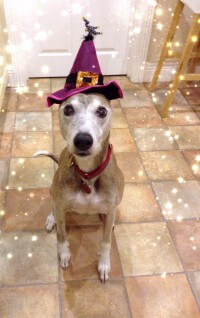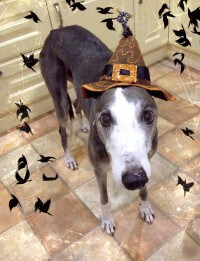Help your dog cope with Halloween & Fireworks’ Night
 Autumn’s here and the nights are fast drawing in. Before we know it, our streets will be filled with ghoulish goings-on and our skies will be lit up with fireworks and the accompanying whizzes and bangs. Whilst this may be fun for us, it’s not always fun for our canine companions, so to help you avoid Halloween Howls & Firework Frights, we’ve compiled a list of some hints and tips to help.
Autumn’s here and the nights are fast drawing in. Before we know it, our streets will be filled with ghoulish goings-on and our skies will be lit up with fireworks and the accompanying whizzes and bangs. Whilst this may be fun for us, it’s not always fun for our canine companions, so to help you avoid Halloween Howls & Firework Frights, we’ve compiled a list of some hints and tips to help.
Autumn nights with little light…
It’s amazing how spooky things look in the dark, and once the dark nights arrive, it’s not uncommon for some dogs to become reluctant to go outside. Things look very different: everyday objects that can be seen in the daylight, can become sinister looking at night, sounds carry more and things smell different (fires are lit etc), which can make familiar places become a little scary for some dogs.
Here are our tips to help autumn evening walks go smoothly:
- If you can, walk your dog before it becomes dark (particularly on Halloween and Bonfire Night)
- If you can’t walk your dog in the daylight, invest in a torch for you, a flashing collar for your dog and a high vis jacket (for both of you – if you like!). It’s much better to see and be seen when you’re walking a dog in the dark and if, like me, you live in a setting with little street lighting, you’re going to need a torch to make sure that you can clean up after your dog.
- Toilet breaks – It’s much better to accompany your dog into the garden when they need a p or p and to make sure that no fireworks are likely to go off, or trick & treaters are going to come lurching up the path. It only takes one frightening experience, such as a loud firework going off, when your dog is outside alone, to make them not want to go out in the dark. Prevention is key.
Avoiding Halloween Howls
The only howls I want to hear at Halloween are those in a horror movie on my TV! Halloween can be fun for both humans and hounds with a little preparation and understanding on both sides….

- Costumes – Remember, dogs aren’t like humans when it comes to wearing costumes. We have a choice on what we wear and can easily tell someone, or decide not to wear it, if it’s uncomfortable. Our dogs can’t.
If you would like your dog to wear a costume or hat, you need to introduce it gradually – rather than just plonking it on your dog’s head and expecting them to wear it! To do this, working with a reward marker, such as a clicker, and some super tasty food rewards will help make the costume something your dog wants to wear, rather than an uncomfortable and, possibly, frightening appendage:
i. Start off just showing your dog the hat – click & feed a food reward each time he/she looks at the hat (at this stage it’s nowhere near your dog’s head)
ii. Gradually reduce the distance between the hat and your dog’s head (clicking & feeding the food reward each time your dog looks at the hat)
iii. Once your dog is comfortable with the hat being nearly on his head, gently touch your dog’s head with the hat, remove the hat and then click & reward [Rinse & Repeat Several Times]
iv. When your dog is comfortable with the hat/costume touching him/her then you can move to placing it on their head for a second, gradually building up the time they can wear it. For example: first few times – put hat on, click, remove hat, reward. When your dog is used to this, put hat on, count to 1, click, remove hat, reward. If your dog is happy at this stage, increase the count to 2 – repeat process several times, before increasing to 3 seconds and so on.

Remember you are your dog’s guardian and protector – if you think they will not be comfortable with wearing a hat or costume don’t make them wear one or feel obliged to dress them up just because it’s Halloween.
What to do if your dog backs away from the costume/hat? Chances are you’ve jumped too far ahead with your training and gone at a speed that’s too fast for your dog to be comfortable. Go back several stages in your training.
Our tips for a happy hallowe’en:
- Trick or Treat – Recurrent doorbell ringing, can set your dog off barking and disturb your evening. You could always teach your dog that the sound of the doorbell, means ‘go settle on your mat’ OR you could leave a sign on your door asking trick or treaters NOT to ring the bell, but to help themselves to 1 or 2 sweets from the bowl on the step.
Taking your dog trick or treating with you may not be a good idea either as all those humans dressed up in costumes, looking scary and odd could be very stressful for your dog. - Sweeties – Remember to keep any sweets out of the way of hungry hounds’ noses… Eating chocolate can be fatal for dogs and the artificial sweetener – Xylitol – if eaten by our dogs it can cause insulin release, which in turn can lead to liver failure. So please don’t leave your dog unattended in a room where sweets and candy are within easy reach.
- Decorations – If you’re celebrating Halloween with decorations such as carved pumpkins, fake spider webs and more, remember to make sure your dog can’t eat them.
- Fancy dress parties – A houseful of friends, family and guests, can sometimes be overwhelming for humans, let alone dogs! Make sure to provide your dog with a quiet place that he/she can escape to away from the hubbub. Dogs can get overwhelmed, overexcited and overtired – just like us – and sometimes need a quiet place to escape to where they can have forty winks. A room, that’s off limits to guests, with some soft bedding, a few toys, treats and water bowl is ideal.
Avoiding Firework Frights
 Guy Fawkes has a lot to answer for! Not only did he fail in his attempt to blow up the Houses of Parliament, but each year the sky is filled with loud whizzes and bangs in his name. It doesn’t seem to be restricted to the 5th of November either… firework displays seem to go on for at least a week before and after the 5th.
Guy Fawkes has a lot to answer for! Not only did he fail in his attempt to blow up the Houses of Parliament, but each year the sky is filled with loud whizzes and bangs in his name. It doesn’t seem to be restricted to the 5th of November either… firework displays seem to go on for at least a week before and after the 5th.
Sudden loud and unusual noises such as can be very frightening and stressful for some dogs. To help your dog cope, you can help prepare them by following a desensitization programme with a special noises such as the Sound Proof Puppy Training app, which can be downloaded onto your phone. However, if you haven’t had time for this, and your dog becomes afraid, what can you do?
Our top tips to prepare for bonfire night:
- Provide a safe den/hiding place – This could be by the side of your bed, under a table – wherever your dog feels most comfortable. This is the equivalent of providing a safe ‘bolt hole’ – ideally away from the noises and with some soft bedding and a range of chews.
- Shut all doors/windows/curtains & turn the TV up
- If you know that fireworks are going to happen – give your dogs a stuffed chew toy or something like a frozen Kong before the fireworks start
- Calming remedies – An ADAPTIL (dog appeasing pheromone) collar, plug in diffuser and/or spray could help (read more here). A thundershirt, which is a tight fitting, calming coat, may help too (read more here) or a herbal supplement such as valerian and skullcap* (see Dorwest Herbs site) can help.
- Don’t be afraid to reassure your dog! Contrary to popular belief, you cannot reinforce fear by reassuring your dog (that is, gentle strokes, soft voice etc). Just leaving your dog to go ‘cold turkey’ with something they’re afraid of is more like to reinforce their fear, rather than reassurance (read Patricia McConnell’s article on reinforcing fear here and see Suzanne Clothier’s video here)
If, however, you know your dog really can’t cope with fireworks do go and see your vet, who may be able to prescribe something to help.
Additional resources:
- Dogs & Fireworks website – www.dogsandfireworks.com
- David Ryan’s website – Dog Secrets
- APDT UK – Preparation for the firework season
- The Royal (Dick) School of Veterinary Studies – Halloween Tips (pdf)
- Sound proof puppy training is available via:



